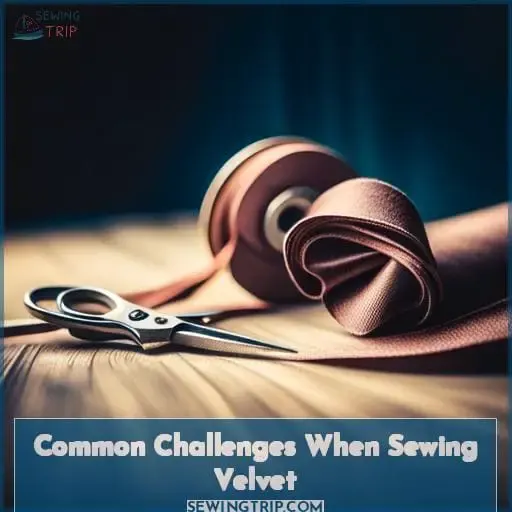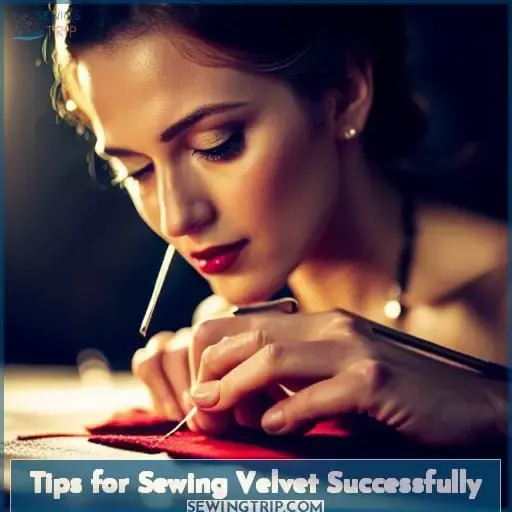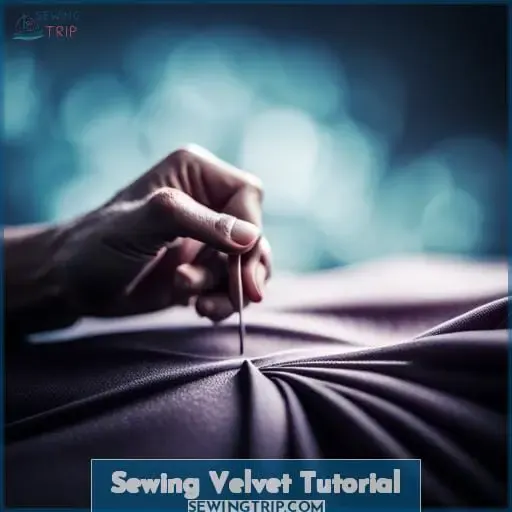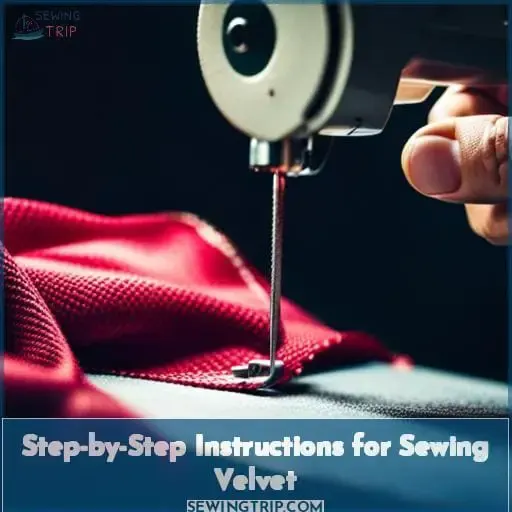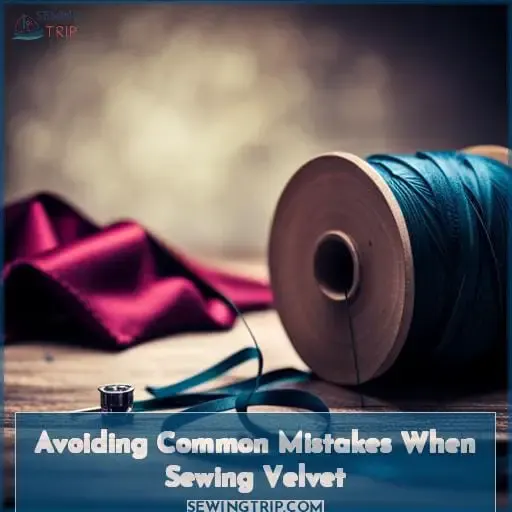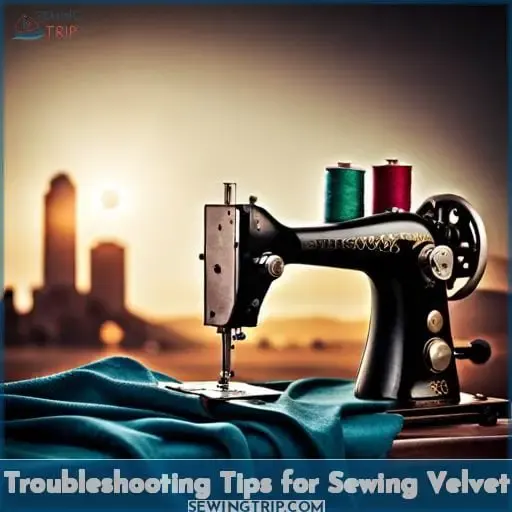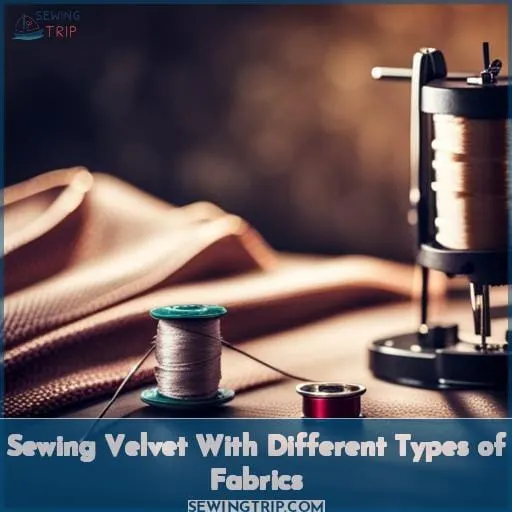This site is supported by our readers. We may earn a commission, at no cost to you, if you purchase through links.
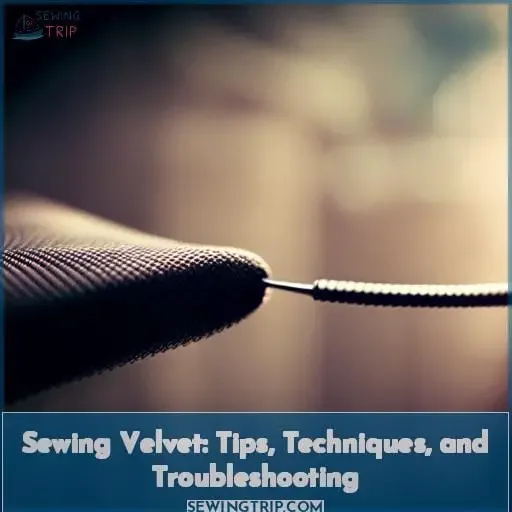 Imagine yourself in a world of luxurious fabrics, where velvet reigns supreme. But sewing velvet can be a challenge, with its slippery nature and delicate pile. Fear not! In this article, we will guide you through the art of sewing velvet like a pro.
Imagine yourself in a world of luxurious fabrics, where velvet reigns supreme. But sewing velvet can be a challenge, with its slippery nature and delicate pile. Fear not! In this article, we will guide you through the art of sewing velvet like a pro.
From choosing the right pattern to troubleshooting common issues, we’ll give you all the tips and techniques you need to conquer any obstacles that may arise while working with this sumptuous fabric.
Get ready to unleash your creativity and master the art of sewing velvet!
Table Of Contents
- Key Takeaways
- Common Challenges When Sewing Velvet
- Tips for Sewing Velvet Successfully
- Sewing Velvet Tutorial
- Step-by-Step Instructions for Sewing Velvet
- Avoiding Common Mistakes When Sewing Velvet
- Troubleshooting Tips for Sewing Velvet
- Sewing Velvet With Different Types of Fabrics
- Finishing Techniques for Velvet Projects
- Frequently Asked Questions (FAQs)
- Conclusion
Key Takeaways
- Slippage and shifting
- Difficulty in cutting and marking
- Pressing issues
- Common mistakes
Common Challenges When Sewing Velvet
When working with velvet, you may encounter some common challenges that can make the sewing process more difficult.
- Slippage and shifting are frequent issues due to the fabric’s pile texture, requiring extra care when pinning and basting.
- Cutting and marking velvet can also be tricky as it tends to shift easily, making it important to use proper cutting techniques like single layer cutting and thread tracing.
- Additionally, pressing velvet requires special attention as direct contact with the iron can crush or flatten its delicate pile surface.
Slippage and Shifting
When sewing velvet, slippage and shifting can be common challenges.
To manage the nap effectively, make sure to cut all pattern pieces in the same direction.
Use pinning strategies such as vertical pins at the seam line.
Hand basting with contrasting thread can provide maximum control during sewing.
Additionally, be cautious when pressing velvet to avoid crushing the fabric’s delicate pile.
By mastering these techniques, you’ll achieve beautiful results with your velvet creations.
Slippage and shifting are common challenges when working with velvet due to its plush pile fabric nature. The soft texture of this luxurious material makes it prone to movement while being sewn or manipulated on a machine or by hand.
To overcome these issues:
- Nap Management: Pay attention to the nap direction of your fabric before cutting out pattern pieces; ensure that they’re all aligned consistently for a cohesive look.
- Pinning Strategies: When pinning seams together, place pins vertically along their length rather than horizontally across them – this helps counteract any potential slipping tendencies caused by layers sliding against each other.
- Hand Basting: In situations where pinning alone is insufficient for securing seams in place (e.g., princess seams), consider hand basting as an additional measure. This involves using long stitches close to the seamline using contrasting thread – making it easier for removal later on without leaving residual marks behind.
- Pressing Care: Velvet requires special attention during pressing due to its delicate nature; avoid placing direct heat from an iron onto its surface which could crush or flatten down its lush pile fibers instead use steam only from afar while gently patting down areas needing smoothing over but not applying pressure directly onto them so as not disturb their fluffy appearance further still lay another piece of scrap Velvet atop what you’re steaming protect underlying area maintain consistency throughout entire process minimizing chances accidental flattening occurring especially if mistakes happen easy fixable just watchful.
Difficulty in Cutting and Marking
To overcome the difficulty in cutting and marking velvet fabric, take specific measures to ensure precision and minimize challenges:
- Consider the nap direction when planning pattern layout.
- Use chalk or tailor’s pencils for marking, but tailor’s tacks are best for velvet.
- Cut mirror image pieces and those on the fold in a single layer to prevent slippage.
- Thread-trace long edges like hems instead of using tracing paper.
Pressing Issues
To address pressing issues when sewing velvet, you can take specific steps to ensure a successful outcome.
One of the main challenges is preserving the delicate velvet pile while achieving smooth seams and hems. To overcome this, use gentle steaming on the wrong side of the fabric with steam protection in place.
Additionally, consider using pressing solutions such as Velvet Pile boards or covering your ironing surface with stiff-pile fabric to protect against crushing and maintain the luxurious texture.
| Pressing Issues | Solutions |
|---|---|
| Crushed Pile | Use gentle steaming on wrong side; protect pile during pressing |
| Seam Impressions | Finger press seams instead of ironing; avoid excessive pressure |
Tips for Sewing Velvet Successfully
When it comes to sewing velvet successfully, there are a few key tips you should keep in mind.
First, choose the right pattern and fabric weight for your project to ensure optimal results.
Second, make sure to properly prepare the velvet by cutting it single layer with attention to the nap direction and using appropriate marking techniques.
Finally, employ specific sewing techniques such as testing stitches on scraps, adjusting tension and presser foot pressure, hand basting seams when necessary,and utilizing lightweight seam finishes and hems for a professional finish.
Choosing the Right Pattern and Fabric
To sew velvet successfully, you need to choose the right pattern and fabric that will complement this luxurious material.
- Consider the weight and drape of velvet when choosing a pattern.
- Opt for patterns with gathers, pleats, or tucks that work well with velvet.
- Use couture-quality closures instead of invisible zippers for a better finish.
By following these guidelines, you’ll be on your way to creating stunning garments with velvet fabric!
Proper Preparation Techniques
To ensure successful sewing with velvet, you should follow proper preparation techniques.
- Cutting the fabric with precision.
- Paying attention to nap direction.
- Using appropriate marking techniques and interfacing choices.
- Employing effective pinning strategies.
Before starting your project, it’s also recommended to prewash velvet fabric for optimal results. By taking these steps into consideration, you can set yourself up for a smooth sewing experience with this luxurious fabric.
Sewing Techniques for Velvet
Mastering sewing techniques for velvet will help you achieve professional-looking results with this luxurious fabric.
When working with velvet, it’s important to choose the right pattern that complements its pile and drape. Cutting precision is key to ensure consistent nap direction across all pieces. Hand basting seams before sewing prevents shifting, while lightweight seam finishes create elegant results.
By following these tips and techniques, you’ll be able to sew your own beautiful velvet garments with ease and perfection.
Sewing Velvet Tutorial
Now that you have a good understanding of velvet fabric and the necessary supplies, it’s time to dive into the sewing tutorial.
In this section, we’ll discuss the characteristics of sewing velvet and provide you with practical tips to ensure successful results. With these techniques in your arsenal, you’ll be able to confidently tackle any project involving this luxurious fabric.
Understanding Velvet Fabric
In this sewing velvet tutorial, delve into the essential aspects of understanding velvet fabric.
Velvet is a luxurious pile fabric known for its softness and rich texture. It can be made from silk, rayon, or synthetic blends.
When working with velvet, it’s crucial to consider its characteristics such as the nap direction and weight to make informed fabric choices.
Understanding these factors will help you master the art of sewing velvet successfully.
Supplies for Sewing Velvet
Now let’s talk about what you’ll need in terms of supplies for sewing velvet.
To work with this luxurious fabric, you’ll want to have some essential tools on hand.
Invest in a sharp pair of fabric scissors specifically designed for cutting luxury fabrics like velvet.
Additionally, consider using a walking foot or Teflon foot when sewing velvet to prevent the fabric from slipping and shifting during stitching.
Having these accessories will ensure that your velvet creations turn out beautifully every time.
Characteristics of Sewing Velvet
As you delve into the art of sewing velvet, it’s essential to understand the unique characteristics that make this fabric both luxurious and challenging to work with.
Consider nap considerations when cutting and marking your fabric, ensuring consistent direction throughout.
Use sew-in interfacing instead of fusible options for better results.
Test stitch length, tension, and presser foot pressure before starting your project.
Employ pinning strategies such as vertical placement for seam security.
Hand basting is crucial for precise seams in velvet projects.
Step-by-Step Instructions for Sewing Velvet
Now that you have a good understanding of velvet fabric and have chosen the right pattern, it’s time to dive into the step-by-step instructions for sewing velvet.
In this section, we’ll cover important points such as:
- Prewashing your velvet
- Cutting the fabric properly
- Marking techniques for precision sewing
- Basting stitches to prevent shifting during machine stitching
- Finally sewing your velvet with finesse.
By following these steps carefully and paying attention to detail along the way, you’ll be able to create beautiful garments using this luxurious fabric.
Prewashing Velvet
To prewash velvet fabric, you should follow these step-by-step instructions:
First, check the care label to determine if the velvet can be washed or if it requires dry cleaning.
If washing is recommended, fill a basin with cold water and add a gentle detergent suitable for delicate fabrics like rayon.
Gently agitate the fabric in the soapy water for a few minutes before rinsing thoroughly with cold water.
Avoid wringing or twisting as this can damage the delicate fibers of velvet.
Finally, lay flat to air dry or hang on padded hangers to prevent stretching.
Cutting Velvet Fabric
Start by laying your velvet fabric flat on a cutting surface.
Ensure the nap direction is consistent across all pieces for a professional finish.
Use tailor’s chalk or pencils to mark your pattern onto the fabric, taking care not to press too hard and crush the pile.
When cutting, go slow and steady with sharp shears or a rotary cutter for clean edges.
Remember to cut single layer pieces and handle with care to avoid shifting.
Marking Velvet
When marking velvet for sewing, use tailor’s chalk or a tailor’s pencil to make precise and visible markings. These tools allow you to mark the fabric without damaging its delicate pile. Alternatively, you can also use tailor’s tacks for even more precision when marking velvet.
By making small snips into the seam allowance, you can create notches that align perfectly during sewing. This ensures accurate construction and helps maintain proper nap alignment throughout your project.
| Velvet Marking | Precision Notching | Chalk vs Tacks |
|---|---|---|
| Use chalk or | Create small snips | Tailor’s tacks |
| a pencil for | in the seam allowance ensure precise | |
| quick visibility of notches |
Pinning Strategies Nap Alignment
Use vertical pins at Mind direction of nap when cutting,
the seams line & be consistent across garment pieces.
reposition them as needed Purchase extra fabric to accommodate
to prevent slippage necessary alterations due to nap changes
Basting the Velvet Stitching
Begin by basting the velvet stitching to ensure precise and secure seams.
Use these basting techniques for seam control:
- Pinning alone is insufficient; hand baste for precision details.
- Baste close to the seam line with contrasting thread.
- Maximize control during sewing by hand basting tricky seams like princess seams or gathers.
- Recognize when pinning isn’t enough and rely on hand basting instead.
Sewing Velvet
To sew velvet successfully, baste the velvet stitching before sewing it permanently.
Below is a table outlining essential techniques for sewing velvet:
| Velvet Seam Finishes | Cutting Challenges | Pressing Velvet |
|---|---|---|
| Serged edges | Nap direction | Delicate steam |
| Hong Kong finish | Mirror image cutting | Use press cloth |
Troubleshoot slippage by using temporary spray adhesive or hand-basting with contrasting thread. For hems, consider single-fold blind-stitched hems to avoid bulk and topstitching.
Sewing velvet requires careful attention to detail and specific techniques to achieve professional results.
-
Prewashing Velvet:
- Check the fabric’s washing instructions.
- If prewashing is allowed, follow the recommended method.
- Dry flat or hang on a padded clothesline.
-
Cutting Velvet Fabric:
- Place your pattern pieces on a single layer of fabric.
- Pay close attention to the nap direction when laying out your pieces.
-
Marking Velvet:
- Avoid using chalk or tailor’s pencils as they may leave visible marks on the surface of the fabric.
- Instead, use tailor’s tacks for marking important points such as notches.
- Basting The Velvet Stitching (See Table):
-
Sewing The Seams:
- Adjust your machine settings according to test samples done earlier in terms of stitch length and tension
- Start at one end of each seam allowance ensuring you have pinned vertically along all seams
By following these steps carefully while paying attention to details like pressing correctly without crushing pile fibers can result in beautifully sewn garments made from luxurious velvets that look stunning!
Avoiding Common Mistakes When Sewing Velvet
When sewing velvet, it’s important to avoid common mistakes that can lead to frustration and disappointing results.
One mistake to watch out for is using the wrong needle and thread combination, which can cause snagging or puckering on the fabric.
Another mistake is ignoring the nap direction of velvet when cutting and sewing, as this can affect how light reflects off the surface.
Lastly, overpressing or underpressing velvet can flatten its pile or create uneven texture respectively; finding a delicate balance with steam pressing is key for achieving professional-looking results.
Using the Wrong Needle and Thread
To avoid common mistakes when sewing velvet, make sure you use the correct needle size and thread.
Here are three important considerations for needle selection and thread choices when working with this luxurious fabric:
- Needle Selection: Use a size 70 or 80 machine needle to prevent snagging or damaging the delicate pile of velvet.
- Thread Choices: Opt for cotton or silk thread that matches your fabric color to ensure seamless stitching that blends seamlessly into the velvet.
- Velvet Troubleshooting: Using the wrong needle and thread can lead to stitching challenges such as skipped stitches, puckering, or uneven tension.
By paying attention to these details, you’ll be able to achieve beautiful seam finishes while avoiding any potential pitfalls when sewing with velvet fabrics.
Ignoring the Nap Direction
Ignoring the nap direction is another common mistake when sewing velvet.
The slipperiness and pile of velvet means slight variations in nap direction will be noticeable.
Marking each velvet piece meticulously and precisely before cutting helps overcome variances.
When cutting, settle overlaps consistently all one direction.
The versatile nature of velvet needs a mastery mindset to avoid this pitfall.
Stay vigilant about nap direction through pressing peculiarities for the best results.
Overpressing or Underpressing
When you’re sewing velvet, overpressing or underpressing can easily ruin your project.
- Overpressing: Applying too much pressure and heat while pressing velvet can crush the delicate pile, resulting in a flattened appearance.
- Underpressing: Neglecting to adequately press seams and hems may lead to wrinkling and an overall unfinished look.
- Maintaining Pile: Properly steaming the wrong side of the fabric while protecting the right side helps maintain the plushness of velvet’s nap.
Troubleshooting Tips for Sewing Velvet
When sewing velvet, you may encounter some common issues that can be frustrating.
Slippage and shifting of the fabric can make it difficult to maintain accurate seam allowances and prevent distortion.
Puckering is another challenge that may arise, especially when dealing with curved seams or areas with multiple layers of fabric.
Additionally, pressing velvet requires special care to avoid crushing the delicate pile.
Understanding these troubleshooting tips will help you overcome these challenges and achieve professional-looking results in your velvet projects.
Handling Slippage and Shifting
If you’re experiencing slippage and shifting while sewing velvet, keeping the fabric in place can be frustrating.
Proper nap management is crucial to prevent your project from going awry.
Utilize pinning strategies to secure the layers together before stitching, such as pinning vertically at the seam line for better control.
Consider hand basting tricky seams or delicate areas to ensure precise results.
And remember, pressing mastery plays a significant role in handling velvet’s unique characteristics during construction.
When working with velvet fabric, one of the most common challenges is dealing with slippage and shifting during sewing. Velvet has a soft pile that tends to move around easily when manipulated or stitched together, causing frustration for sewers who desire precision and flawless finish on their projects.
To overcome this issue successfully and achieve professional-looking results when sewing velvet fabrics, it’s essential to implement specific techniques that address these concerns directly.
Nap Management:
One key aspect of tackling slippage and shifting in velvet is managing its nap direction effectively throughout your project.
- Be mindful of how you purchase your fabric; check if there are any directional markings indicating which way the nap should run.
- Adjusting pattern layout becomes necessary since all pieces must have consistent nap orientation.
- Purchasing extra material allows modifications if changes need to be made regarding accommodating specific directions without compromising design elements.
Pinning Strategies:
Using appropriate pinning methods helps keep layers securely aligned while working with slippery fabrics like velvet.
- When securing two layers together before stitching them along straight seams (such as side seams), consider placing pins horizontally across those lines first—this minimizes movement between garment sections during machine work later on where vertical pins may not provide enough stability alone due mainly because they tend only hold onto individual fibers rather than entire lengths themselves do offer support needed preventing shifts occurring within joints being created through satin stitches used here too many times long edges toward raw edge ones having serger overlock stitch Hong Kong hemming technique.
Hand Basting:
When pinning alone is insufficient to keep velvet layers in place, hand basting comes into play.
- Hand basting refers to temporarily sewing seams together using loose stitches that are easy to remove later on.
- This method provides maximum control and stability during the construction process by preventing slippage and shifting until permanent machine stitching takes place.
- Use contrasting thread for hand basting so that it’s easier to identify and remove once the project is complete.
Pressing Mastery:
Proper pressing techniques can significantly impact how well your velvet fabric behaves throughout the sewing process.
- Avoid directly touching the iron onto velvet as this can crush its delicate pile; instead, use steam or heat from a distance while working with an appropriate press cloth (such as another piece of scrap velvet) underneath your fabric layer being pressed against it prevents crushing effects caused when direct contact occurs between hot metal surface fibers making up piles themselves don’t get compressed too much beyond their original height due mainly thanks those gaps exist between them going back down afterward has finished cooling off after treating accordingly such cases where necessary ensure no significant damage done overall appearance either side affected adversely especially if any decorative motifs present needing preserved intact without distortion whatsoever possible other considerations include controlling moisture levels involved since different water content each type affects behavior differently understanding characteristics critical achieving desired results final outcome looking professional every aspect concerned whether nap directionality pile height fiber density weave structure thickness also taken account considering factors affecting potential shrinkage stretching ability maintaining shape memory keeping consistent tension applied across entire garment area likewise playing role ensuring optimal conditions maintained regarding interaction these aspects managing challenges arise along way toward completion goal set forth beginning journey undertaken
Velvet Combinations:
When working with velvet, it’s important to consider how different fabrics may interact with each other.
- When combining velvet with other materials, such as silk or cotton, be mindful of their compatibility in terms of weight and drape.
- Test stitch samples beforehand to ensure that the chosen fabric combination behaves well together.
- Adjust machine settings accordingly for optimal performance on various combinations.
By implementing these tips and techniques for handling slippage and shifting while sewing velvet fabric, you can overcome the challenges associated with this luxurious material.
Dealing With Puckering and Seam Allowances
To prevent puckering and achieve smooth seam allowances when sewing velvet, make sure to adjust your machine settings and handle the fabric with care.
Here are some essential techniques for achieving seam perfection:
- Use a shorter stitch length to prevent the fabric from slipping between stitches.
- Reduce the presser foot pressure to avoid flattening the pile.
- Gently ease in any excess fabric while stitching, ensuring an even distribution of tension.
- Trim down bulky seam allowances before pressing for a smoother finish.
Properly dealing with puckering and managing your seam allowances is crucial when sewing velvet fabrics that have such delicate surfaces! It can be frustrating if you notice unsightly wrinkles or uneven seams after all your hard work, but fear not – there are solutions! By following these helpful tips below, you’ll be well on your way to achieving perfect stitching every time:
Puckering Prevention Techniques:
- Shorten Your Stitch Length: Using a shorter stitch length will help minimize puckering by creating more secure stitches that hold onto the fabric fibers tightly.
- Reduce Presser Foot Pressure: Velvet has a tendency to flatten under excessive pressure which can lead to unwanted distortion along seams. By reducing presser foot pressure on your machine (if possible), you’ll ensure gentle handling of this delicate material.
- Gentle Fabric Easing: When working with velvet, it’s important not pull or stretch too much during sewing as this can cause unevenness in both width and lengthwise directions resulting in undesirable gathers or pleats forming along garment edges once completed!
- Trimming Excess Seam Allowances: If you find yourself dealing with bulky areas where multiple layers intersect (such as at corners), carefully trim away extra bulk before pressing open flat; this will create smoother lines without compromising durability!
By implementing these tried-and-true techniques into practice consistently throughout each sewing project involving velvet, you’ll be able to achieve flawless seam allowances and enjoy the luxurious beauty of this fabric without any frustrations along the way! Remember, practice makes perfect – so don’t be discouraged if it takes a few tries before mastering these skills.
Resolving Pressing Issues
To resolve pressing issues when sewing velvet, follow these troubleshooting tips:
- Use steam, not the iron, focusing on the wrong side.
- Protect the pile with a scrap.
- Finger press delicate areas.
- Embrace the soft drape and avoid over-pressing.
- Hand baste to control challenging seams and shape.
- Pin vertically at seams to prevent slippage.
Sewing Velvet With Different Types of Fabrics
When sewing velvet with different types of fabrics, such as silk, cotton, or rayon, you need to consider the unique characteristics of each fabric.
Silk and velvet create a luxurious combination with their softness and sheen.
Cotton can provide a more casual look while still offering comfort and breathability.
Rayon blends well with velvet due to its drapey nature.
Understanding the properties of these fabrics will help you achieve successful results when combining them in your projects.
Velvet and Silk
When sewing velvet and silk together, be mindful of the different characteristics each fabric possesses.
Velvet pairs beautifully with silk as a lining option, providing a luxurious touch against the skin.
When working with velvet and silk, consider using sew-in interfacing for added stability without compromising the drape of these delicate fabrics.
To finish seams in this combination, opt for serged edges or explore the elegant technique of a Hong Kong finish to create clean and professional-looking garments.
Velvet and Cotton
When sewing velvet and cotton fabrics together, consider the unique characteristics of each fabric to ensure a successful outcome.
Velvet’s luxurious texture pairs well with the natural breathability and stability of cotton.
To combine them effectively, use stretch velvet for a comfortable fit or line your velvet garment with cotton for added structure.
When interfacing, opt for lightweight options to prevent bulkiness.
Whether hand-sewing or machine sewing, take care to handle both fabrics delicately while maintaining their individual qualities.
Velvet and Rayon
You want to pair rayon with velvet because they’ve similar drape and rich texture.
Rayon’s medium weight offers body, while its fluid drape complements velvet’s plush softness.
Both benefit from gentle laundering.
When sewing velvet and rayon together, adjust your tension and stitch length for smooth, even seaming.
Their shared luxurious hand creates garments with an alluring, sensual quality.
With proper care, rayon’s beauty enhances velvet’s richness.
Finishing Techniques for Velvet Projects
Now we’ll look at the finishing techniques for your velvet project.
Proper seam and hem finishes are key to a quality velvet garment. Take care to select lightweight, non-bulky methods that preserve the fabric’s drape and sheen.
Seam Finishes for Velvet
To finish your velvet projects with a professional touch, there are various seam finishes that work well with this luxurious fabric.
- Consider serged edges for a clean and neat look.
- Try the elegant Hong Kong finish using strips of tulle fabric wrapped around raw edges.
- Opt for blind hems to create a seamless and streamlined appearance.
Hem Finishes for Velvet
To achieve a polished and professional finish for your velvet projects, opt for appropriate hem finishes.
For a clean and streamlined look, consider using single-fold hems. These can be blind-stitched by hand to avoid bulkiness and visible topstitching.
Another option is serged edges, which provide durability while maintaining the fabric’s elegance.
If you want to add an extra touch of luxury, try the Hong Kong finish using bias-cut flannel strips to create beautiful bound edges on your velvet garments.
Frequently Asked Questions (FAQs)
How do I prevent the pile of velvet from matting or crushing during sewing?
Prevent the pile of velvet from matting or crushing by using:
- A walking foot
- Adjusting machine settings
- Finger pressing seams
Support the fabric with scrap velvet when ironing and pin vertically to counteract slipping.
Master the art of sewing velvet!
What types of sewing machine needles work best for sewing velvet?
To achieve velvet sewing mastery, select size 70 or 80 machine needles.
These mighty tools effortlessly glide through the lush fabric,
empowering you to conquer any project with elegance and finesse.
Embrace your power!
Can I use a regular iron to press velvet fabric, or do I need a specific tool?
To achieve professional results, use a velvet board or cover your ironing surface with stiff-pile fabric. Avoid direct contact between the iron and velvet to prevent crushing the delicate pile.
Are there any special considerations when it comes to sewing velvet with other fabrics?
When sewing velvet with other fabrics, mind the contrast in texture and drape.
Choose lightweight companions that won’t overpower the luxurious feel of velvet.
Experimentation will reveal harmonious pairings, unlocking your mastery over fabric combinations.
Can I machine wash or dry clean velvet garments, or do they require special care?
To maintain the luxuriousness of velvet garments, it’s best to dry clean them. Machine washing can lead to damage and loss of pile. Show your mastery by opting for special care that preserves their power and allure.
Conclusion
Embrace the richness and elegance of sewing velvet with confidence using these expert tips and techniques.
By understanding the common challenges of working with velvet, such as slippage and cutting difficulties, and implementing proper preparation and sewing techniques, you can conquer any obstacles that arise.
From choosing the right pattern and fabric to troubleshooting common issues, this article has provided you with all the knowledge you need to sew velvet like a pro.
Say goodbye to problems sewing velvet and hello to flawless creations!

